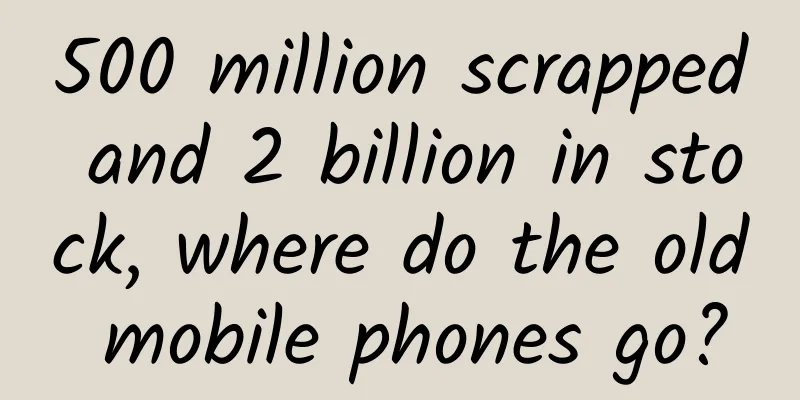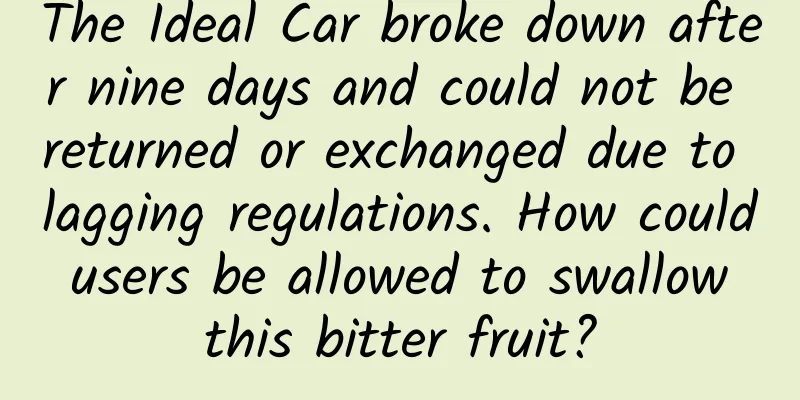500 million scrapped and 2 billion in stock, where do the old mobile phones go?

|
How many old cell phones do you have at home? With 500 million discarded cell phones and more than 2 billion cell phones in stock, how do you deal with and recycle them? Written by reporter Zhao Tianyu, Photo and text editor Chen Yongjie New Media Editor/Lai Tianying Interview experts Lv Bin (Researcher, Eco-Environmental Research Center, Chinese Academy of Sciences) Kan Kaili (Professor at the Institute of Information Industry Development, Beijing University of Posts and Telecommunications) At the just-concluded National People's Congress, Lei Jun, deputy to the National People's Congress and chairman and CEO of Xiaomi Group, proposed in his proposal that the country should formulate an overall medium- and long-term development plan for the recycling of electronic waste, while preventing the leakage of personal information by old mobile phones and other devices, and increasing the recycling rate of electronic waste; and carry out a personal carbon credit pilot project to promote participation by the entire population. ▲The total stock of second-hand mobile phones in China exceeds 2 billion (Photo source: Tuchong Creative) When it comes to recycling electronic waste, mobile phones have the largest stock and are most closely related to the general public. According to data from the Ministry of Industry and Information Technology, the total number of mobile phone users of my country's three basic telecommunications companies has reached 1.6 billion. In 2020, China produced a total of about 524 million used mobile phones. From 2014 to date, China's stock of second-hand mobile phones has accumulated to more than 2 billion. China is not only the world's largest producer and consumer of mobile phones, but also the world's largest producer of used mobile phones. Where do used mobile phones go? With 500 million scrapped phones and more than 2 billion in stock, it is clear that whether we can properly handle used mobile phones and reasonably incorporate them into the circular economy system while ensuring user privacy and security has become a major issue that must be addressed in the process of promoting the carbon neutrality strategy. ● ● ● Used mobile phones are full of treasures Compared with the hesitation in purchasing a mobile phone, many people are very decisive when discarding their old mobile phones. They don’t care about the destination of the mobile phones at all, or simply choose to "leave them idle", and they become abandoned "electronic waste". In fact, used mobile phones are full of treasures and have high recycling value, so they need to be recycled; but at the same time, used mobile phones are also major contributors to environmental pollution, so they must be recycled. "Mobile phones are essentially electronic products and chemical products, and their parts contain harmful substances such as lead, cadmium and mercury." Lu Bin, a researcher at the Ecological and Environmental Research Center of the Chinese Academy of Sciences, said that if old mobile phones are simply discarded, it will cause damage to the environment. "A used mobile phone battery can pollute 60,000 liters of water. Its pollution intensity is 100 times that of an ordinary dry battery. Substances such as lead, cadmium and mercury can penetrate the soil and affect the quality of groundwater," said Lu Bin. The media once reported on the world's largest electronic waste dump in Ghana, Africa. Every year, more than 5 million tons of various discarded electronic products are manually "dismembered" by more than 40,000 farmers in the surrounding area and then incinerated and landfilled. This not only releases a large amount of toxic gas, but also destroys groundwater. While harmful minerals exceed the standard, the precious metal content of used mobile phones is also not low, even higher than gold and silver ore of the same mass, which deeply interprets the meaning of "gold will always shine." It is understood that the gold content of electronic waste from non-smartphones before 2015 is 60 to 100 times that of ore of the same quality. About 400 grams of gold, 2,300 grams of silver, and 172 grams of copper can be extracted from 1 ton of used mobile phones; in comparison, only about 5 grams of gold can be extracted from mining 1 ton of gold sand. ▲Chemical elements in mobile phones (Photo source: Science Popularization China) Guiyu Town in Shantou, Guangdong, once known as the capital of China's waste electronic appliances, was able to refine no less than 15 tons of gold in 2014, accounting for about 5% of my country's annual gold production. The 5,000 medals of the Tokyo Olympics, which has been postponed to 2021, are made of metals refined from 80,000 tons of waste electronic products donated by Japanese citizens, including 5 million old mobile phones. However, Lv Bin admitted: "In the past, the metal content of old Nokia mobile phones was very high. Now, with the improvement of industry, the manufacturing cost of mobile phones has been reduced, and the saved profits are used for chips and screens. Therefore, the content of precious metals in mobile phones, especially gold, is decreasing year by year, far from the level of refining 400 grams of gold." Although the content of precious metals has decreased, the density of lithium batteries has increased. The lithium batteries of used mobile phones also contain lithium, cobalt, and nickel, and these mineral elements are not useless. Data shows that the recycling value of cobalt metal in waste lithium batteries in 2021 was as high as 996 million yuan; the recycling value of lithium metal was smaller, but it could reach about 317 million yuan. Both can increase the supply source of some materials in China, have good economic efficiency, and the recycling value is also very high. ● ● ● Old machine recycling from dismantling to selling How to recycle old mobile phones? Many people will think of a roadside stall holding a sign to recycle mobile phones, or a loud speaker at a rural market shouting "Old mobile phones for stainless steel basins". But those scenes have become a thing of the past. With the development of the times and the improvement of ecological environmental awareness, the mobile phone recycling industry has gradually completed the transformation from "mainly dismantling" to "mainly selling", and major mobile phone manufacturers are also constantly improving the old-for-new and recycling services. A staff member who has been engaged in the mobile phone recycling industry for many years told reporters that second-hand mobile phones generally have four distribution channels: secondary sales, export to foreign countries, dismantling parts and refining metals. After quality inspection and appearance processing, the second-hand products will be resold on relevant Internet platforms such as Zhuanzhuan, Aihuishou, and Xianyu, or directly sold to retailers and wholesalers for offline transactions. Some second-hand machines have a high cost-effectiveness and are recognized and even sought after by the market. The 2020 Second-hand 3C Consumption Annual Report shows that the current market size of 3C digital products recycling in my country has exceeded 100 billion yuan, which is equivalent to the annual GDP of Tongzhou District, Beijing. Many domestic platforms specializing in second-hand mobile phone recycling, such as Aihuishou and Zhuanzhuan, have developed rapidly and become more and more mature. Some companies have even gone public overseas and expanded their business to the world. Some second-hand idle goods trading platforms, such as Xianyu, also have many active individual users. In addition to domestic sales, a considerable number of second-hand mobile phones are also exported to developing countries and regions such as Africa and Southeast Asia. The communication infrastructure in these regions is generally backward, and the requirements for smartphones are not high. For example, the smartphones with the highest shipment volume in Africa are 1GB RAM + 8GB memory, 2GB RAM + 16GB memory, and 3GB RAM + 32GB memory, and the retail price is less than RMB 500 to meet the demand. It is said that before the epidemic, there were a large number of sellers from Africa, India, Pakistan, Myanmar, Iran and other countries looking for second-hand mobile phones in the Feiyang Market in Huaqiangbei, Shenzhen. Even the sales staff in some countries "almost did not look at the price when taking the goods", which shows that domestic second-hand mobile phones are very attractive and there is huge market space overseas. Some old mobile phones are seriously damaged and have lost their repair value, but the parts in the mobile phones still need to be disassembled. They will be disassembled into motherboards, screens, batteries, cameras, memory, etc. Lu Bin said that these parts are often reused. Some will be sent to mobile phone assembly factories to be assembled into new mobile phones, and some will be sold as parts, such as mobile phone memory, chips, etc. The "corpses" of second-hand mobile phones after being disassembled into parts, and some old mobile phones with extremely low recycling value, will be used to extract heavy metals. Mobile phone manufacturers usually cover various interfaces on the mobile phone motherboard with a few microns of gold to improve conductivity. However, the structure of mobile phone motherboards is relatively complex, and even the fully automatic motherboard disassembly technology basically does not exist now, so the general practice is to disassemble manually first, and then use hydrometallurgy to extract. Taking the data provided by Aihuishou as an example, 20% to 30% of the mobile phones received will be environmentally friendly and degraded, 60% will flow to offline recyclers through auctions, and 15% to 20% will be used for resale. ● ● ● Standardization is imminent The "Global E-waste Monitoring Report 2020" released by the United Nations University, the National Telecommunication Union and the International Solid Waste Association shows that my country's annual e-waste processing volume has reached about 80 million tons, and the standardized recycling rate is less than 20%, while Europe has reached 42.5%. In the category of mobile phones, the recycling rate has dropped sharply to 2%. In 2020, the number of discarded mobile phones generated in my country was about 500 million. According to this ratio, only 10 million mobile phones were formally recycled. The remaining more than 400 million mobile phones were either stored at home by users or disposed of in an environmentally unfriendly and non-compliant manner, resulting in serious waste of resources. Du Huanzheng, director of the Institute of Circular Economy at Tongji University, believes that the low-cost recycling of electronic waste is an unresolved problem that has affected the overall development of the industry. He suggested that the production and recycling links should be taken into consideration at the beginning of product design, such as being easier to disassemble and recycle; in the production process, as little toxic and hazardous substances as possible should be added or alternative solutions should be adopted, so as to ultimately achieve low-cost recycling of electronic waste. In Lu Bin's opinion, there are many reasons for this phenomenon, but policy is always an important factor. It is necessary for relevant departments to strengthen support for the mobile phone recycling industry. He explained that mobile phones were included in the "Catalogue of Waste Electrical and Electronic Products Disposal" as early as 2014. Corresponding to this catalogue is the "Measures for the Collection, Use and Management of Waste Electrical and Electronic Products Disposal Fund", which is the country's specific subsidy measures for the disposal of waste electronic products. "The subsidy policy has been adjusted many times over the years, but the detailed rules for mobile phones have never been released," said Lu Bin. This means that companies involved in mobile phone recycling have been in a zero subsidy state, which is in sharp contrast to electronic products such as refrigerators and home appliances, and can easily limit the enthusiasm and initiative of participants. Taking Aihuishou, the industry leader, as an example, although the gross profit margin increased from 14.1% in 2018 to 25.7% in 2020, the company's losses increased from 210 million yuan in 2018 to 470 million yuan in 2020, with a cumulative loss of 1.38 billion yuan in three years, resulting in a revenue inversion. In other words, although Aihuishou took big steps, it did not actually make any money, and even lost more and more. In addition to environmental protection and policies, concerns about privacy and security leaks have also "forced" many consumers to leave their used mobile phones idle. Kan Kaili, a professor at the Institute of Information Industry Development at Beijing University of Posts and Telecommunications, believes that this concern is real: "After restoring the factory settings, consumers cannot ensure that their personal information is completely erased. The IMEI code, a unique identification code of a mobile phone, can also be technically bound to personal payment accounts such as Alipay and WeChat, which poses a risk of privacy leakage and even property loss." To solve these problems, Kan Kaili suggested that in line with the principle of "whoever sells is responsible", manufacturers should be encouraged to recycle used mobile phones and use brand credibility to eliminate consumers' doubts; at the same time, relevant departments should conduct serious research and introduce laws and regulations applicable to the recycling and circulation of used mobile phones as soon as possible, strictly enforce the regulations, strengthen supervision and regulation, and ultimately form a "industry code" with high binding force. Produced by: Science Central Kitchen Produced by: Beijing Science and Technology News | Beijing Science and Technology Media Welcome to share to your circle of friends Reproduction without authorization is prohibited |
<<: Learned! It turns out that there are at least 5 ways to die from the new coronavirus...
>>: I rubbed my eyes and saw strange patterns. Did I peek into the secrets of heaven?
Recommend
10 common misunderstandings about operations!
In writing this article, I would like to clarify ...
Due to insufficient production capacity, Xiaomi SU7 will have to wait until the end of the year to deliver 150,000 orders. Is it still worth buying?
Xiaomi Auto SU7 caused a huge response in the mar...
Brand marketing promotion, 6 common psychological effects!
Contemporary people often present some strange co...
Google search guru Manber leaves
[[127749]] The Wall Street Journal has just revea...
New media operation: data mining method!
Unlike traditional marketing and promotion method...
The dead bird was reborn as a drone, and will fly with the flock of birds. I wonder if other birds can find out that it died a long time ago...
The dead bird flapped its wings again and soared ...
FF is listed on the US stock market and will start mass production and delivery within 12 months. Jia Yueting: I must return to China!
On July 22, local time in the United States, Fara...
Apple has come up with a patent to make the iPhone waterproof
Apple is considering designing a waterproof iPhon...
The winning formula for brands to capture the minds of Generation Z!
China’s current consumption structure and consume...
How much does it cost to be an agent of Meizhou Tattoo and Embroidery Mini Program?
Is it easy to be an agent of Meizhou Tattoo and E...
Marketing promotion: Starbucks cat claw cup becomes a hit, is it hunger marketing at work?
As the main body in the social system, people see...
How to establish the AARRR model data indicator system?
The AARRR model is our classic model for user ana...
International Cheetah Day丨It’s the king of speed and has a strong “gang of men”, but this “big cat” is not happy?
It has a slender body, sometimes elegant, sometim...
Practical Methodology for B-side Operations to Acquire 50,000+ Customers
This article summarizes the overview of China'...
Attention! Eating unripe beans can cause poisoning!
Review expert: Peng Guoqiu, deputy chief physicia...









